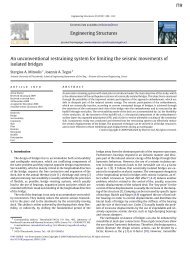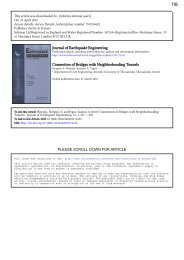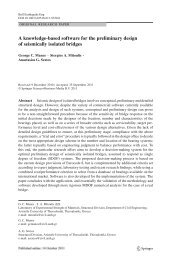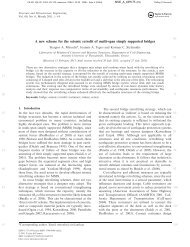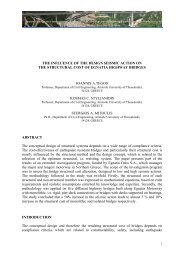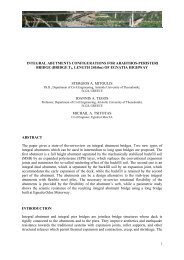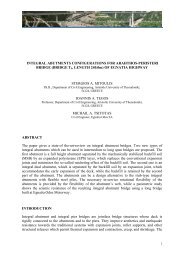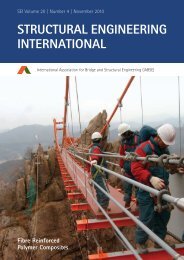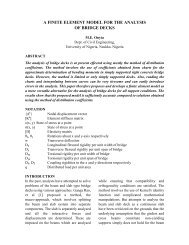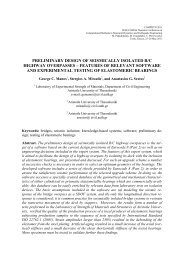18 Preliminary design of seismically isolated RC highway overpasses
You also want an ePaper? Increase the reach of your titles
YUMPU automatically turns print PDFs into web optimized ePapers that Google loves.
George C. Manos, Stergios A. Mitoulis and Anastasios G. Sextos<br />
bearings that are manufactured by international companies. In addition, due to the complexity<br />
<strong>of</strong> the above process and although permissible according to the codes, in most cases the <strong>design</strong>ers<br />
are reluctant to use experimentally tested products <strong>of</strong> the local industry, hence, they<br />
lean primarily towards commercially manufactured products <strong>of</strong> the international market.<br />
3 THE PROPOSED KNOWLEDGE-BASED DECISION MAKING SYSTEM<br />
The methodology presented herein for the preliminary <strong>design</strong> <strong>of</strong> base <strong>isolated</strong> bridges is<br />
described in detail. The methodology applies to all bridges <strong>isolated</strong> with low damping steel<br />
laminated elastomeric bearings (LDRBs), with the exception <strong>of</strong> cases where monolithic pierdeck<br />
or abutment-deck connections are combined with bearing-type pier-deck connections.<br />
The verification <strong>of</strong> the methodology is given in section 6 <strong>of</strong> the paper and shows satisfactory<br />
results in straight bridges. The structure <strong>of</strong> the KBES can be summarized in the following<br />
three steps, which also conceptually comply with those proposed by [13].<br />
3.1 Step 1: User Input<br />
A database <strong>of</strong> commercially available and experimentally tested elastomeric bearings is<br />
first compiled consisting <strong>of</strong> bearings’ properties, (i.e. shear stiffness G), shape (i.e., rectangular<br />
or circular), rubber and steel plate thickness, height, and width, overall area (A) and dimensions<br />
(B x , B y or D). Possible bridge structural systems, characterized by different number<br />
and length <strong>of</strong> middle and central spans (L 1 or L 2 ), that define the total bridge length (L tot ) and<br />
the mass per unit length (m), as well as initial configurations <strong>of</strong> n bearings are herein defined<br />
by the <strong>design</strong>er. Seismic hazard is also considered with the most commonly used parameters<br />
in mind, i.e. the <strong>design</strong> seismic acceleration (S a ), soil type and the importance factor <strong>of</strong> the<br />
bridge under study.<br />
3.2 Step 2: Decision process<br />
The second step <strong>of</strong> the methodology includes the necessary and basic calculations and<br />
checks for the <strong>seismically</strong> <strong>isolated</strong> bridge. The <strong>design</strong>er decides the acceptable range for bearing<br />
compression (σ e ) where a minimum <strong>of</strong> 2.0 MPa and a maximum value <strong>of</strong> 5.0 MPa are<br />
proposed by the system itself according to [14]. The limit for the bearing’s compression ensures<br />
that friction will be adequate to avoid the sliding <strong>of</strong> the bearing during seismic shear<br />
loading, whereas the upper limit is given to ensure that the shear strain due to the interaction<br />
between the neoprene and the steel plates under compression will remain at acceptable limits<br />
(i.e., εc,d ≤ 2.5 according to Eurocode 8 Part 2). It is noted that this limitation is optional, in<br />
the sense that it is not explicitly imposed by the codes, however, it is good common practice.<br />
For instance, the vast majority <strong>of</strong> the bearings used in <strong>isolated</strong> bridges built along the Egnatia<br />
Highway have been <strong>design</strong>ed not to exceed 5.0 MPa in compression. As such, the compression<br />
criterion is adopted as the first filter applied to all the bearings checked.<br />
Based on the mass <strong>of</strong> the bridge, the compression stress (σ e ) is derived as a ratio <strong>of</strong> the total<br />
vertical load acting on each bearing (P i ) over its own area (A). The criterion proposed by<br />
Eurocode 8-Part 2 for the calculation <strong>of</strong> the maximum effective normal stress <strong>of</strong> the bearing is<br />
herein adopted:<br />
2b <br />
min<br />
e<br />
<br />
3t <br />
t<br />
where σ e is maximum effective normal stress <strong>of</strong> the bearing, b min is the minimum dimension<br />
<strong>of</strong> the bearing, t t is the total thickness <strong>of</strong> the elastomeric, G the shear modulus <strong>of</strong> the elastomer<br />
and S min the minimum shape factor <strong>of</strong> the bearing layers.<br />
GS<br />
min<br />
(1)<br />
4






